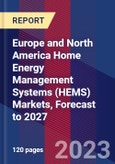How should the utility and mobile industries address the vast business opportunity in home energy management systems? The publisher estimates that the installed base of HEMS in Europe and North America will grow at a compound annual growth rate of 43.8% from 1.5 million units in 2022 to 9 million units in 2027. Get a 360 degree perspective on the rapid evolution of the HEMS market in this comprehensive 120 page strategy report.
In this study, a HEMS is defined as a system that at minimum consists of a solar PV system, battery storage system and a web-based management portal or smartphone app that allows for remote monitoring and control of the system. A wider HEMS also integrates backup generators, EV chargers, heat pumps, home appliances and other connected products and systems in the home.
There were an estimated 950,000 HEMS installed in European homes at the end of 2022. An estimated 320,000 systems were added to the installed base during the year. This figure includes both new installations of solar PV + battery storage systems as well as installations of battery storage systems in existing solar PV systems (i.e. retrofits). The penetration rate is still very low in Europe, below 1%. Germany is by far the leading market. Growing at a CAGR of 40.3%, the installed base of HEMS in Europe is estimated to reach 5.2 million systems at the end of 2027. There were at the same time an estimated 520,000 HEMS installed in North American homes at the end of 2022. Shipments including both new installations and retrofits reached 250,000 systems during the year. Only about 0.5% of the houses and MDUs in the region now have a HEMS installed. The installed base of HEMS in North America is estimated to grow at a CAGR of 49.4% to reach 3.9 million systems at the end of 2027.
The HEMS value chain spans various companies from different industry sectors. Some companies are vertically integrated, offering a complete HEMS based on in-house developed hardware and software solutions. Other companies develop and manufacture one of the components of HEMS. Some of these companies integrate components from third-party companies to be able to offer a complete HEMS. There are also several companies that specialises in providing a software platform that enables other companies to offer HEMS. US-based Enphase Energy, Tesla and Generac, Israel-based SolarEdge, and Germany-based E3/DC (Hager Group), Senec (EnBW) and Solarwatt are leading companies in the HEMS market in North America and Europe. All seven companies offer a range of software and hardware solutions that make it possible to control the electricity generation, storage and usage at home. Additional important players in the European and North American HEMS market include Germany-based Kostal, SMA Solar and Sonnen (Shell); Italy-based FIMER (McLaren Applied); Austria-based Fronius; France-based Schneider Electric; and US-based Eaton, SimpliPhi Power (Briggs & Stratton) and Tigo Energy. There are also a number of Asia-based companies active in Europe and North America. Key players include BYD Electronic, LG Energy Solution, Huawei, Growatt New Energy and Pylon Technologies.
“A number of factors indicate that the market for HEMS is on the verge of entering a strong growth period that will last for several decades”, says the Principal Analyst of the report. The residential sector accounts for about a fourth of the total energy consumption in North America and Europe. As the adoption of electric cars and heating systems are expected to grow fast during the coming years, household electricity consumption is also expected to increase. “The ability to control and optimize the household energy consumption and even generate and store electricity in the home will be of key importance for both individual households and the society as a whole going forward”, the analyst continues. HEMS help homeowners to reduce the electricity bill and increase independence from the electricity grid.
Highlights from the report:
- Insights from 20 executive interviews with market leading companies.
- Comprehensive overview of the HEMS value chain and key applications.
- In-depth analysis of market trends and key developments.
- Statistical data on residential solar PV system adoption in Europe and North America.
- Profiles of 42 companies active in the solar PV, battery storage and HEMS industry.
- Detailed market sizing and forecasts lasting until 2027.
The report answers the following questions:
- Which are the main applications within HEMS?
- How important are government subsidies and tax reductions for adoption?
- What are the business models and channels-to-market for HEMS solutions?
- Which are the leading HEMS providers in Europe and North America?
- Which are the main connectivity technologies and standards?
- What is the potential market size for cellular IoT in the HEMS market?
- How will the HEMS market evolve in the next five years?
- Which are the main trends in the industry?
Table of Contents
Samples

LOADING...
Companies Mentioned (Partial List)
A selection of companies mentioned in this report includes, but is not limited to:
- Alarm.com
- BYD Electronic
- E3/DC (Hager Group)
- Eaton
- Eguana Technologies
- Enphase Energy
- Ferroamp
- FIMER (McLaren Applied)
- FranklinWH Energy Storage
- Fronius
- Generac
- GivEnergy
- GridX (E.ON)
- Growatt New Energy
- Homey (Athom)
- Huawei
- Kiwigrid
- Kostal
- Legrand
- Leviton
- LG Energy Solution
- Lumin
- Lunar Energy
- myGEKKO (Ekon)
- Polarium Energy Solutions
- Pylon Technologies
- Savant Systems
- Schneider Electric
- Senec (EnBW)
- SimpliPhi Power (Briggs & Stratton)
- SMA Solar Technology
- Smappee
- SolarEdge
- Solarwatt
- Sonnen (Shell)
- SPAN
- Tesla
- Tibber
- Tigo Energy
- Tiko Energy Solutions (Engie)
- Varta
- Viessmann Climate Solutions (Carrier)
Methodology

LOADING...








